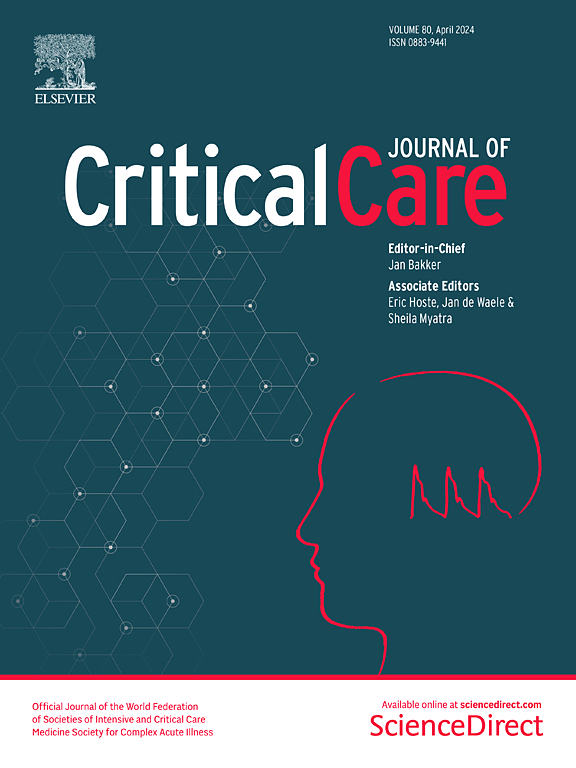Intraosseous versus intravenous vascular access in out-of-hospital cardiac arrest: a systematic review and meta-analysis of randomized controlled trials
IF 8.8
1区 医学
Q1 CRITICAL CARE MEDICINE
引用次数: 0
Abstract
Rapid and reliable vascular access is crucial during cardiopulmonary resuscitation for out-of-hospital cardiac arrest (OHCA). While intraosseous (IO) and intravenous (IV) access are used, their comparative effectiveness for patient outcomes remains uncertain. We searched PubMed, Embase, and ClinicalTrials.gov for RCTs comparing IO vs. IV access in adults with OHCA. The primary outcome was survival (30 days or until discharge), while secondary outcomes included sustained ROSC, favorable neurological outcome, successful first-attempt vascular access, and time from emergency medical service arrival to access. Pooled odds ratios (OR), mean differences (MD), and 95% confidence intervals (CI) were calculated. Four RCTs with 9475 patients were included. No significant differences were found between IO and IV groups in survival (6.6% vs. 6.9%, OR 0.99, 95% CI 0.84–1.18) or favorable neurological outcome (4.7% vs. 4.6%, OR 1.07, 95% CI 0.88–1.30). The sustained ROSC rate was numerically, but not significantly, lower in IO vs. IV access (24.6% vs. 27.0%, OR 0.92, 95% CI 0.80–1.06). IO access had a higher first-attempt success rate (92.3% vs. 62.3%; OR 6.18, 95% CI 3.50–10.91) and was 15 s faster than IV for vascular access (IO: 11.03 ± 5.57, IV: 11.35 ± 6.16 min, MD − 0.25, 95% CI − 0.48 to − 0.01). IO access had a higher first-attempt success rate and faster establishment than IV access, but no significant differences were found in survival or favorable neurological outcomes in adults with OHCA. Sustained ROSC was numerically lower with IO access than IV access, although the difference was not statistically significant.院外心脏骤停的骨内与静脉血管通路:随机对照试验的系统回顾和荟萃分析
在院外心脏骤停(OHCA)的心肺复苏中,快速可靠的血管通路至关重要。虽然使用了骨内(IO)和静脉(IV)通道,但它们对患者预后的相对有效性仍不确定。我们检索了PubMed、Embase和ClinicalTrials.gov中比较成人OHCA患者静脉注射与静脉注射的随机对照试验。主要结局是生存(30天或直到出院),而次要结局包括持续ROSC、有利的神经系统结局、首次尝试血管通路成功以及从紧急医疗服务到达到进入血管的时间。计算合并优势比(OR)、平均差异(MD)和95%置信区间(CI)。纳入4项随机对照试验,共9475例患者。IO组和IV组在生存率(6.6% vs. 6.9%, OR 0.99, 95% CI 0.84-1.18)或良好的神经预后(4.7% vs. 4.6%, OR 1.07, 95% CI 0.88-1.30)方面无显著差异。持续ROSC率在数值上低于静脉注射(24.6% vs. 27.0%, OR 0.92, 95% CI 0.80-1.06)。IO访问的第一次尝试成功率更高(92.3% vs. 62.3%;OR为6.18,95% CI为3.50-10.91),血管通路比静脉注射快15 s(静脉注射:11.03±5.57 min,静脉注射:11.35±6.16 min, MD为- 0.25 min, 95% CI为- 0.48 ~ - 0.01)。与静脉输注相比,静脉输注具有更高的首次尝试成功率和更快的建立速度,但在成年OHCA患者的生存或良好的神经预后方面没有发现显着差异。持续ROSC在数值上低于静脉注射,尽管差异无统计学意义。
本文章由计算机程序翻译,如有差异,请以英文原文为准。
求助全文
约1分钟内获得全文
求助全文
来源期刊

Critical Care
医学-危重病医学
CiteScore
20.60
自引率
3.30%
发文量
348
审稿时长
1.5 months
期刊介绍:
Critical Care is an esteemed international medical journal that undergoes a rigorous peer-review process to maintain its high quality standards. Its primary objective is to enhance the healthcare services offered to critically ill patients. To achieve this, the journal focuses on gathering, exchanging, disseminating, and endorsing evidence-based information that is highly relevant to intensivists. By doing so, Critical Care seeks to provide a thorough and inclusive examination of the intensive care field.
 求助内容:
求助内容: 应助结果提醒方式:
应助结果提醒方式:


